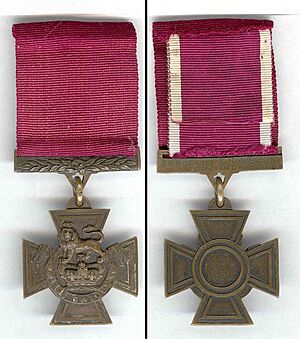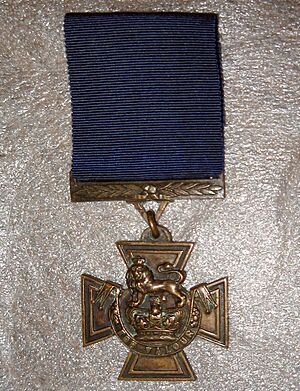Victoria Cross facts for kids
Quick facts for kids Victoria Cross |
|
|---|---|
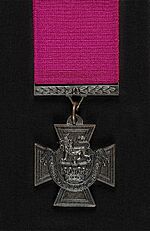
Obverse of the cross; ribbon: 1+1⁄2 inches (38 mm), crimson (blue ribbon for naval awards 1856–1918)
|
|
| Type | Military decoration |
| Eligibility | Persons of any rank in the Naval, Military and Air Forces of the United Kingdom, its colonies or territories, and Commonwealth countries that award UK honours; members of the Merchant Navy; and civilians serving under the orders, directions or supervision of any of the above-mentioned forces or services |
| Awarded for | "... most conspicuous bravery, or some daring or pre-eminent act of valour or self-sacrifice, or extreme devotion to duty in the presence of the enemy" |
| Status | Active |
| Description | Bronze Cross pattée with Crown and Lion Superimposed, and motto: "For Valour" |
| Clasps | Bars can be awarded for further acts of valour |
| Post-nominals | VC |
| Statistics | |
| Established | 29 January 1856 |
| Order of Wear | |
| Next (higher) | None |
| Next (lower) | George Cross (Equal in stature) |
Ribbon bar  Second award bar |
|
The Victoria Cross (VC) is the highest and most respected award for bravery in the United Kingdom. It is given to members of the British Armed Forces for incredible courage when facing the enemy. This special medal can also be given after someone has passed away.
The VC was once awarded to service members across the wider British Empire. Now, many independent nations have their own awards. The Victoria Cross can be given to any military rank. It can also be given to civilians working under military command. However, no civilian has received it since 1879.
Queen Victoria first presented these awards in 1857. Since then, most VCs have been given by the British monarch in person. These special ceremonies usually take place at Buckingham Palace.
Queen Victoria created the VC on January 29, 1856. This was to honor brave acts during the Crimean War. Since then, the medal has been awarded 1,358 times to 1,355 different people. Only 15 VCs have been awarded since the Second World War.
People used to think the metal for the VCs came from a Russian cannon. This cannon was captured during the siege of Sevastopol. However, research shows that most medals made since 1914 came from two Chinese cannons.
The Victoria Cross is very valuable. Some have sold for over £400,000 at auctions. Many collections are dedicated to the Victoria Cross. Lord Ashcroft has a private collection of over one-tenth of all VCs ever awarded.
Countries like Canada, Australia, and New Zealand have created their own national awards. These awards are similar to the Victoria Cross. They are called the Victoria Cross for Australia, the Canadian Victoria Cross, and the Victoria Cross for New Zealand. Each country now recommends and presents its own awards.
Contents
The Story Behind the Victoria Cross
Why the Victoria Cross Was Created
Before the Crimean War, Britain did not have a standard way to recognize bravery. Officers could receive certain awards. But there was no special medal for all brave soldiers. Other European countries had awards for all ranks. People in Britain felt a new award was needed. It had to recognize bravery no matter a person's social class.
Queen Victoria officially created the VC on January 29, 1856. The award was made to include brave acts from 1854. This meant soldiers from the Crimean War could receive it.
Queen Victoria wanted a simple medal. It would be highly valued by all military members. She chose the name Victoria Cross. The first ceremony was held on June 26, 1857. Queen Victoria presented 62 medals in Hyde Park, London.
How the Victoria Cross Is Made
A single company, Hancocks & Co, has made every VC since it began.
It was believed that all VCs were made from Russian cannons. These cannons were captured at the siege of Sevastopol. However, studies show that most VCs since December 1914 use metal from old Chinese guns. These Chinese cannons were likely taken during the First Opium War.
A small piece of the original cannon metal still exists. It weighs about 10 kilograms. It is kept in a special vault. Experts believe about 80 to 85 more VCs could be made from this metal.
What the Victoria Cross Looks Like
The medal is a bronze cross. It is about 41 mm high and 36 mm wide. It shows the crown of Saint Edward with a lion on top. The words "for valour" are written on it. Queen Victoria changed the words from "for the brave." She felt the original words suggested only medal winners were brave.
The cross hangs from a "V" shape. This "V" is connected to a bar decorated with leaves. The ribbon passes through this bar. The back of the bar has the recipient's name, rank, and unit. The back of the medal shows the date of the brave act.
The ribbon is crimson, about 38 mm wide. Originally, army awards had a red ribbon. Naval awards had a dark blue ribbon. But the dark blue ribbon was stopped in 1918. This happened after the Royal Air Force was formed. In 1920, King George V decided all VCs would have a red ribbon.
Since 1917, a tiny copy of the cross is attached to the ribbon bar. This is worn when the full medal is not. If someone receives a second VC, a second tiny cross is added.
How the Victoria Cross Is Awarded
Choosing Who Gets the Medal
The Victoria Cross is given for "most noticeable bravery, or some daring act of courage or self-sacrifice, or extreme devotion to duty when facing the enemy."
An officer usually suggests someone for the VC. This suggestion needs support from three witnesses. The suggestion then goes up the military chain of command. It finally reaches the Secretary of State for Defence. The monarch then approves the award.
VC awards are always announced in The London Gazette. The only exception was the award to the American Unknown Soldier in 1921. Most awards have been presented by the reigning British monarch.
At first, VCs were not given after someone died. But this policy changed over time. By 1920, the rules allowed for posthumous awards. About one-quarter of all VCs from World War I were given after the recipient had died.
Sometimes, the selection process has been seen as inconsistent. Some believe VCs are given more often for actions that senior military leaders want to highlight. The 1920 rules also allowed women in the Armed Forces to receive the VC. However, no woman has ever been awarded one.
Special Rules for Awards
If a group of soldiers or sailors acts bravely together, a ballot can be held. The officers choose one officer. Non-commissioned officers (NCOs) choose one person. Private soldiers or seamen choose two people. This way, everyone in the group is recognized.
In total, 46 VCs have been awarded by ballot. The last ballot awards for the army were in 1915. The last naval ballot awards were in 1918. This rule is still in place, but it has not been used since 1918.
Between 1858 and 1881, the VC could be given for brave acts not directly facing the enemy. Six such awards were made. In 1881, the rules changed again. The VC was then only for acts of bravery "in the face of the enemy."
Awards to Colonial Troops
The Victoria Cross was extended to colonial troops in 1867. This happened after a brave act by Major Charles Heaphy in the New Zealand Wars. He was serving under British command.
Later, countries like New Zealand created their own awards. But the VC could still be awarded to colonial troops. For example, four Australian soldiers received the VC in the Vietnam War. Britain was not directly involved in that conflict.
Indian troops became eligible for the VC in 1911. Before that, they had their own award, the Indian Order of Merit. The first VCs to Indian troops were given in December 1914.
Separate Awards in Commonwealth Countries
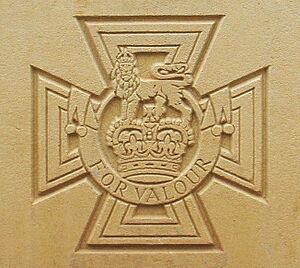
Since the Second World War, many Commonwealth countries have created their own awards. They no longer use the British honours system. India and Pakistan, for example, introduced their own awards after 1947.
Australia, Canada, and New Zealand have created their own versions of the Victoria Cross. The Australian and New Zealand VCs look exactly like the British one. They are even made from the same gunmetal. The Canadian Victoria Cross is similar. But its motto is in Latin, "pro valore", meaning "for valour." It also includes metal from Canadian regions.
The Victoria Cross for Australia has been awarded six times. The Victoria Cross for New Zealand has been awarded once. The Canadian Victoria Cross has been cast once. It was meant for the Canadian Tomb of the Unknown Soldier.
Special Privileges of the Victoria Cross
High Status of the Award
The Victoria Cross is the highest award for bravery in the United Kingdom. It is always the first award presented at ceremonies. It is also the first medal worn in a row of medals. The VC is always listed first in a person's post-nominal letters.
The George Cross (GC) is for similar brave acts not facing the enemy. It has equal importance to the VC. But it is awarded second because it is a newer medal.
There is a tradition that all military ranks salute a VC holder. This is not an official rule. But it is widely followed. Even senior officers will salute a private soldier who has received a VC.
The VC is worn on the left side of the chest. It is the first decoration in a row of medals. A smaller version of the cross can also be worn on special occasions.
Financial Support
In the past, some VC recipients received a yearly payment. Today, holders of the Victoria Cross or George Cross receive an annuity. The amount depends on the awarding government. Since 2015, the British Government pays £10,000 per year. This payment is tax-free for British taxpayers.
Canada and Australia also provide yearly payments to their VC recipients.
Forfeited Awards
The original rules allowed a VC to be taken away. This could happen if a recipient did something very dishonorable. Eight VCs were taken away between 1861 and 1908.
However, King George V strongly believed the award should never be taken away. In 1920, he stated that no matter the crime, a VC recipient should keep their medal. The power to cancel and restore awards is still in the VC rules.
Victoria Cross Recipients
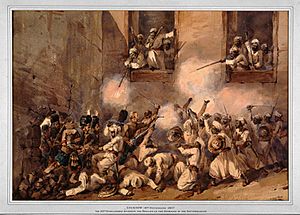

A total of 1,358 Victoria Crosses have been awarded since 1856. The most VCs awarded on a single day was 24. This happened during the Indian Mutiny on November 16, 1857. The most VCs won by one unit in a single action was seven. This was for the defense of Rorke's Drift during the Zulu War. The most VCs won in one conflict was 628 during the First World War.
Ishar Singh was the first Indian Sikh to receive the award. In 2006, eight of the 12 living VC holders attended a special service. This service marked the 150th anniversary of the VC.
Three people have received the VC and a Bar. A Bar means a second award of the VC. These are Noel Godfrey Chavasse, Arthur Martin-Leake, and Charles Upham. Chavasse and Martin-Leake were doctors who rescued wounded soldiers. Upham was an infantryman who fought bravely. Upham is the only combat soldier to receive a VC and Bar.
Since the Second World War, the original VC has been awarded 15 times. This includes awards in the Korean War, Indonesia-Malaysia confrontation, Vietnam War, Falklands War, Iraq War, and War in Afghanistan.
In 1921, the British Unknown Warrior received the US Medal of Honor. In return, the Victoria Cross was given to the American Unknown Soldier from World War I. This is the only VC award not officially announced.
Public Sales of the Victoria Cross
More than 300 Victoria Crosses have been sold publicly since 1879. Others have been sold privately. The value of the VC has grown over time. In 1955, a VC sold for £300. By 2004, a VC sold for £235,250. In 2006, a VC sold for A$1 million (about £410,000). In 2009, a VC and Bar sold for almost £1.5 million.
Stolen Victoria Crosses
Several VCs have been stolen. Because they are so valuable, they are on Interpol's watch-list. A VC awarded to Milton Fowler Gregg was stolen from a museum in Canada in 1980. It is still missing. Another VC, awarded to Filip Konowal, was stolen from the same museum in 1973. It was found in 2004.
In 2007, nine VCs were stolen from a museum in New Zealand. This included Charles Upham's VC and Bar. A large reward was offered. All the medals were recovered in 2008.
Victoria Cross Collections
Many collections of Victoria Crosses exist. Lord Ashcroft has the largest collection. It has 162 medals. This is over one-tenth of all VCs ever awarded. In 2008, Lord Ashcroft donated £5 million for a special gallery. This gallery is at the Imperial War Museum in London. It opened in 2010. It displays 210 VCs and 31 George Crosses.
Before this gallery opened, the Australian War Memorial had the largest public collection. It holds about 70 VCs. This includes all nine VCs awarded to Australians at Gallipoli.
Many museums around the world have collections of VCs. Some of these VCs are on loan. They are owned by individuals, not the museums themselves.
Remembering the Victoria Cross
Memorials and Tributes
In 2004, a national Victoria Cross and George Cross memorial was placed in Westminster Abbey. This is near the tomb of the Unknown Warrior. Westminster Abbey is a famous place with memorials to important British figures.
A historian named Canon William Lummis created a record of VC holders. This work was continued by David Charles Harvey. His book, Monuments to Courage, is a key source. In 2007, the Royal Mail used Lummis's records for a collection of stamps. These stamps honored Victoria Cross recipients.
In the Australian Army, soldiers' clubs are often named after VC recipients. Australia also has Remembrance Drive. This road links Sydney and Canberra. Along the route, there are 23 rest stops named after Australian VC recipients. These stops have picnic areas and facilities.
Valour Road is a street in Winnipeg, Canada. It is named after three World War I VC recipients. They all lived on the same block of that street. This story is also told in a short film in Canada.
Victoria Cross in Art
Artists have often shown soldiers earning the VC. Louis William Desanges painted 50 such artworks in the 1850s and 1860s. Many of these paintings were displayed in London. Later, they were gathered into the Victoria Cross Gallery.
During the Second World War, images of brave acts were used in pamphlets. These images are now available online. In 2016, a photographer took portraits of all living Victoria Cross and George Cross recipients.
See also
 In Spanish: Cruz Victoria para niños
In Spanish: Cruz Victoria para niños
- List of military actions for which a Victoria Cross was awarded
- Dickin Medal (The animals' VC)


